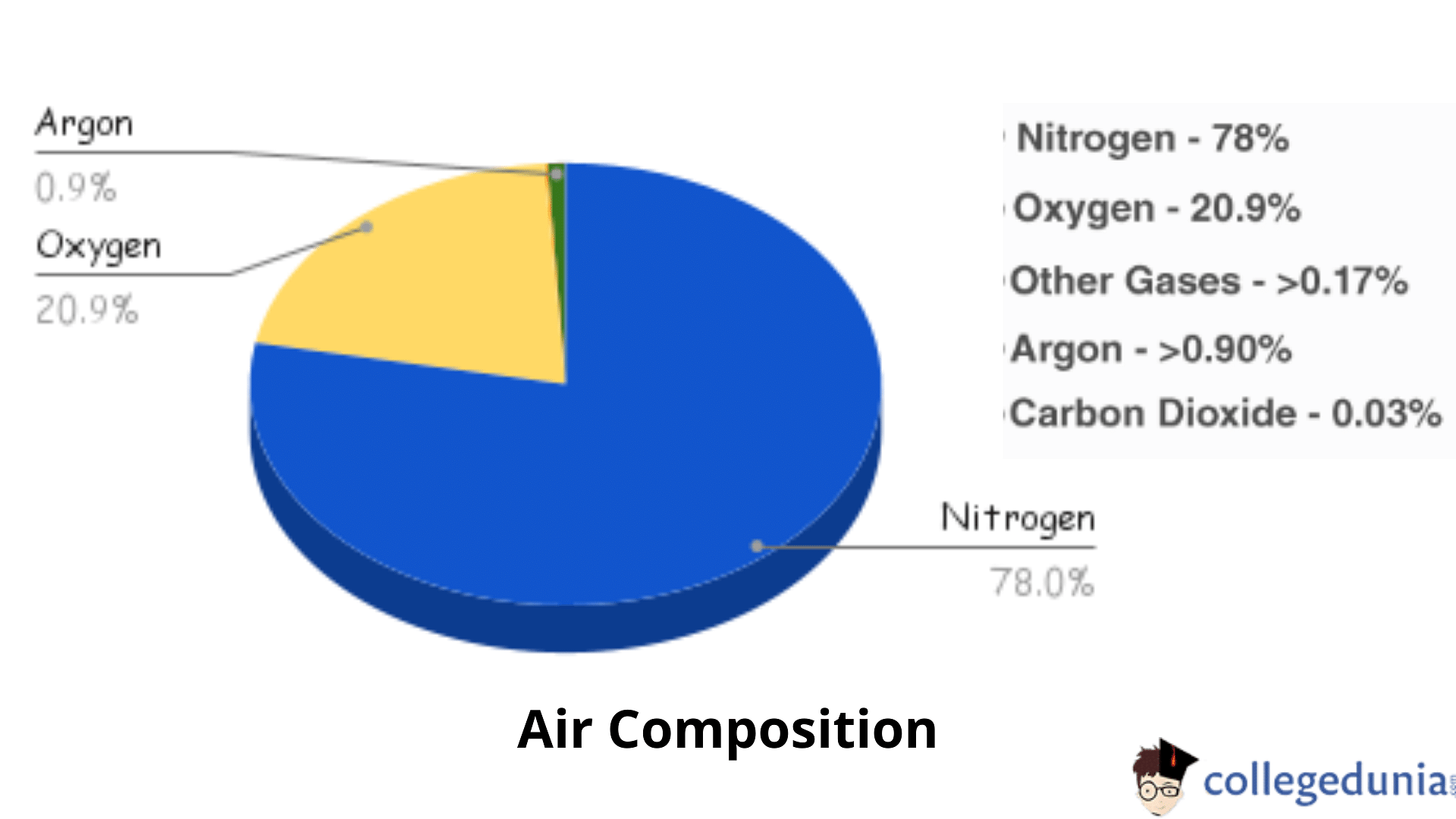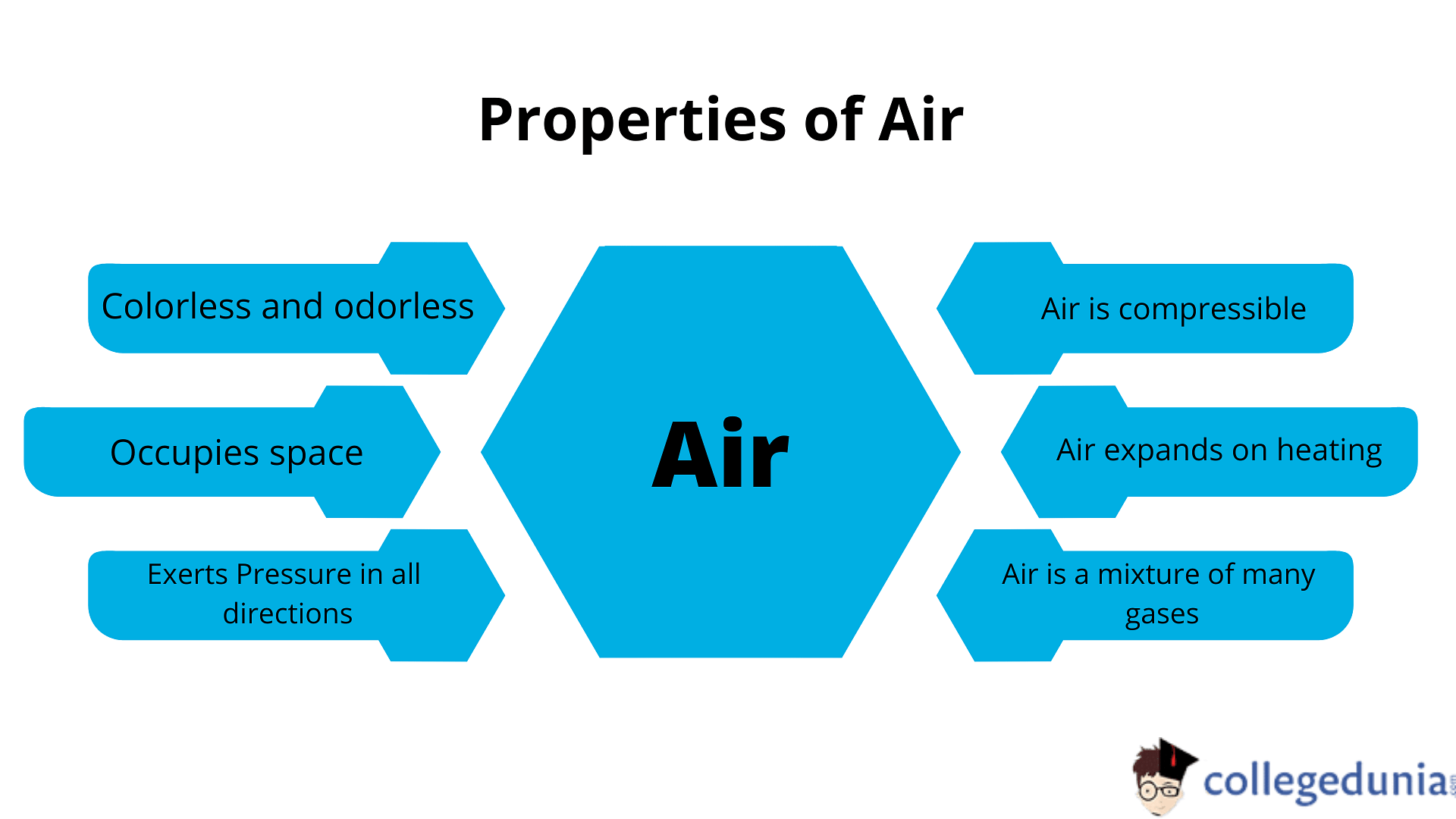Jasmine Grover Content Strategy Manager
Content Strategy Manager
Air is a matter that is an inevitable part of our lives. The atmosphere refers to the blanket of air that covers the Earth. Air is needed by all organisms for their survival. Air is composed of many elements such as gases, water vapours, dust particles, and many more. The earth’s atmosphere is filled with air. The air composition has 78% of nitrogen, 21% of oxygen and other trace elements. Air also has water vapour and dust particles. Air is an indispensable resource for the respiration of all living organisms.
| Table of Content |
Key Terms: Air composition, Compression, Nitrogen, Oxygen, Dust particles, Smoke, Atmosphere.
Air Composition
[Click Here for Sample Questions]
Air is composed of many components such as gases (oxygen, nitrogen, carbon dioxide), trace gases, dust particles, smoke etc.
- Air is not only essential for breathing, but it is also necessary for other abiotic components present in our surroundings.
- The percentage of different gases in the composition of air is shown below in the form of a pie diagram.

Air Composition
Read More:
Chemical Composition of Air
[Click Here for Sample Questions]
A mixture of gases present in the air collectively makes up the atmosphere. In the atmosphere, the composition of air does not change when it varies from one layer to another layer. Moreover, the content of moisture and dust particles varies from layer to layer. The gases in the atmosphere are colourless and odourless. The composition of air includes 78% nitrogen, 21% oxygen and 1% of other gases and water vapour.
The composition of air doesn't change through various layers of the atmosphere whereas the number of molecules changes. The moisture content varies from one place to another. Arid regions have less moisture compared to wetlands.
Some interesting facts about the chemical composition of air are mentioned below:
- In the air, the maximum moisture-carrying capacity depends on the temperature.
- The composition of air is not changed until the elevation of approximately 10.000 m.
- In the air, the temperature diminishes at the rate of 0.60 C for each 100 m vertical height.
- The standard atmosphere is the unit of pressure that is defined as the mean atmospheric pressure at sea level.
- The pressure exerted by the 760 mm column of mercury at sea level and standard gravity of 32.174 ft/sec2 is known as one standard atmosphere.
The table below shows the number of elements (gases) in the air and their weight, percentage, volume, molecular weight as well as their chemical formula.
| Name of the Element(Gases) | Chemical Formula of Element | Volume by % | Weight by % | PPM(parts per million) by volume | Molecular Weight of the Element |
|---|---|---|---|---|---|
| Nitrogen | N2 | 78.08 | 75.47 | 780790 | 28.01 |
| Oxygen | O2 | 20.95 | 23.20 | 209445 | 32.00 |
| Argon | Ar | 0.93 | 1.28 | 9339 | 32.00 |
| Carbon Dioxide | CO2 | 0.040 | 0.062 | 404 | 44.01 |
| Neon | Ne | 0.0018 | 0.0012 | 18.21 | 20.18 |
| Helium | He | 0.0005 | 0.00007 | 5.24 | 4.00 |
| Krypton | Kr | 0.0001 | 0.0003 | 1.14 | 83.80 |
| Hydrogen | H2 | 0.00005 | Negligible | 0.50 | 2.02 |
| Xenon | Xe | 8.7 x 10-6 | 0.00004 | 0.087 | 131.30 |
- Nitrogen, Oxygen and Carbon dioxide are present in bulk in the atmosphere and are also known as principal gases of air.
- Trace gases are present in lesser amounts in the atmosphere. For example, Argon, Hydrogen, Xenon, Helium, Krypton, Neon.
Other Components of Air
Some other components of air present in lesser quantities are as mentioned below:
- Sulfur dioxide (SO2) – 1.0 ppm
- Ozone (O3) – 0 to 0.07 ppm
- Nitrogen dioxide (NO2) – 0.02 ppm
- Methane (CH4) – 2.0 ppm
- Nitrous oxide (N2O) – 0.5 ppm
- Iodine (I2) – 0.01 ppm
- Ammonia (NH3) – 0 to trace ppm
- Carbon monoxide (CO) – 0 to trace ppm
Properties of Air
[Click Here for Sample Questions]
Some of the main properties of air are discussed below:
Colourless and Odourless
Air does not have any colour as well as odour. Air is essential for breathing for all living organisms. If the air is moving then it is called wind. Air is transparent.
Occupies Space
Air is considered a matter. So, it also has mass and weight like other matter(or gases). When we dip an empty bottle into the bucket filled with water then bubbles come out of the bottle, which means that the bottle is not empty air is filled in the bottle. When we tilt the bottle air escapes and water starts entering the bottle. Air occupies the space in the bottle.

Air Exerts Pressure in all Directions
Air exerts pressure due to its weight is called air pressure. Air pressure decreases as the height increases. When we start filling the air in the balloon then the balloon starts expanding due to air pressure.
Air Expands
Air has expanding property. On heating, the air starts expanding and occupies space. Due to expansion, the air becomes thinner. Therefore, a cold wind has more pressure than warm wind.
Air is compressible
When we open the cap of the cold drink then carbon dioxide (CO2) inside the bottle comes out with pressure. This shows that air is compressed inside the bottle.
Temperature
Temperature also affects the air. With the rise in temperature of the air, the motion of air molecules also gets faster.
Effect of Height on Air
Air is affected by height. Due to an increase in altitude/height, the pressure of air falls. That's why Everest climbers carry oxygen cylinders with them as oxygen is thinner at higher altitudes or mountains. Oxygen cylinders help them in breathing.
Things to Remember
- A thin layer of air known as the atmosphere protects the earth.
- Nitrogen and Oxygen are present in excess amounts in the atmosphere.
- A few trace gases are present in the air composition ( around 1%).
- Air has neither colour nor odour.
- As temperature increases, the motion of air molecules also increases.
- Height and air pressure are inversely proportional to each other.
Sample Questions
Ques. What do you mean by the chemical composition of air? (5 marks)
Ans. Air is composed of many elements such as nitrogen, oxygen, carbon dioxide, trace gases, dust particles, and water vapours. All these gases collectively make the atmosphere. The number of air molecules present in the atmosphere decreases and becomes less. Also, there are some interesting facts about the composition of air which are written below:
- The moisture content is more in the arid regions as compared to the wetlands.
- Air contains nitrogen 78%, oxygen 21%, water vapours and other gases 1%.
- In the air, the maximum moisture-carrying capacity depends on the temperature.
- In the air, the temperature diminishes at the rate of 0.60 C for each 100 m vertical height.
- The pressure exerted by the 760 mm column of mercury at sea level and standard gravity of 32.174 ft/sec2 is known as One Standard Atmosphere.
Ques. Write down the main components of air. (3 marks)
Ans. There are many elements present in the air. The important components of air are mentioned below:
- Nitrogen (78%)
- Oxygen(21%)
- Argon (0.9%)
- Carbon Dioxide(0.04%)
- Water vapours, trace gases and other dust particles.
Ques. Write down the main properties of air. Briefly explain each of them. (5 marks)
Ans. The important properties of air are discussed below. Let’s see:
- Colourless and Odourless: Air is invisible and we can only feel it. Air does not show any colour as well as smell. Air is essential for humans and animals for their survival.
- Volume: Air takes up the volume(shape and size)of the container in which it takes place.
- Weight/ Mass: Air is a matter which has its weight and mass. Also, air occupies the space. The empty balloon and balloon filled with air have different weights.
- Air exerts pressure: Air exerts pressure in all directions. This pressure is due to its weight. When we start filling the air in the balloon then the balloon starts expanding due to air pressure.
- Compression: Air is compressible. We can compress the air under high pressure. When we open the cap of the cold drink then carbon dioxide (CO2) inside the bottle comes out with pressure.
- Expansion: Air expands when heat is provided. After expansion, air occupies more space and becomes thinner.
- Temperature: With the rise in temperature, the motion of air molecules increases.
- Height: With the increase in height, the air pressure goes down.
Ques. Write down the name of different layers of the atmosphere. (2 marks)
Ans. There are five main layers of the atmosphere:
- Thermosphere
- Stratosphere
- Troposphere
- Exosphere
- Mesosphere
Ques. What is the need for oxygen cylinders for mountaineers while climbing in the mountains? (2 marks)
Ans. We all know that air pressure decreases when altitudes or height increase. Oxygen is also present in the air. So, the amount of oxygen present also decreases with a rise in height. Oxygen is essential for breathing and if climbers do not get proper oxygen, they might face difficulty in breathing. To avoid this difficulty, mountaineers have to carry oxygen cylinders that aid the supply of oxygen.
Ques. Which gas in the atmosphere is essential for respiration? (3 marks)
Ans. In the atmosphere, oxygen gas plays an important role in respiration. Respiration is the process in which the production of energy(in the form of ATP) takes place in living organisms. In respiration, oxygen is taken and carbon dioxide is released from the oxidation of complex organic substances. The dissolved air in water is used by aquatic animals for respiration. There are two main kinds of respiration. Such as:
- Aerobic respiration: Aerobic respiration is cellular respiration that takes place in the presence of oxygen to produce energy. Also, aerobic respiration is continuous and takes place within the cells of animals as well as plants.
- Anaerobic respiration: Anaerobic respiration is also cellular respiration but it takes place in the absence of oxygen to produce energy.
Ques. How do plants and animals help each other in the exchange of oxygen in the atmosphere? (2 marks)
Ans. Plants produce oxygen while preparing their food. Also, plants consume the maximum carbon dioxide present in the atmosphere. However, animals inhale oxygen and release carbon dioxide into the environment. This carbon dioxide is used by plants. So, both of them depend on each other for their survival.
Ques. What is the importance of air? (3 marks)
Ans. Air is an essential component that is responsible for the existence of life on earth. Some of the important uses of air are mentioned below:
- A thin layer of air protects the atmosphere from the environment.
- Air is mandatory for the survival of living organisms.
- Air helps maintain the temperature of the earth.
- The photosynthesis process also needs air.
Check out:



Comments